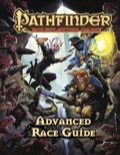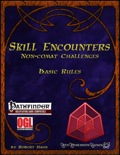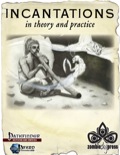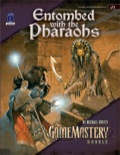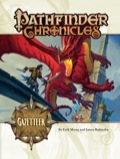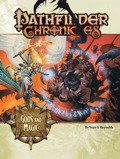Sign in to create or edit a product review. A must have for every gamerThe Advanced Race Guide is divided into four chapters: Chapter 1 pertains to the Core Races and has several options for each of the seven core races; Chapter 2 pertains to Featured Races and includes descriptions and options for sixteen of the more popular non-core races in the Bestiaries; Chapter 3 pertains to the fourteen Uncommon Races, which include races from the Dragon Empires Gazetteer, as well as others that lend themselves to great storytelling; and lastly Chapter 4 is the Race Builder and includes an impressive array of overwhelming options to build or modify your own races. Chapter 1: Core Races includes dwarves, elves, halflings, gnomes, half-elves, half-orcs and humans. Each race includes new racial traits that can be swapped for standard ones to crate a more unique version your chosen race, a couple of new racial class archetypes that do an amazingly good job of capturing the flavor of each race, new racial subtypes that make a lot of sense, racial equipment, racial feats, racial spells, and even racial magic items. There is a LOT of good stuff in here. My favorite race is the dwarf, naturally, and I have to admit, Paizo did a fantastic job with new options. Chapter 2: Featured Races include Aasimirs, Catfolk, Dhampirs, Drow, Fetchlings, Goblins, Hobgoblins, Ifrits, Kobolds, Orcs, Oreads, Ratfolk, Sylph, Tengu, Tieflings, and Undines. WOW!! I was impressed with the Catfolk and Ratfolk especially. I never cared for them before but the flavor of these races begs to be played over and over. I am about to start paying an Undine in the Skull and Shackles AP and those options have really impressed me and given me some great ideas. After reading these races I would allow them in any of my games as a core race. While some may have some overpowered abilities they are compensated quite well. Chapter 3: Uncommon Races include Changelings, Duergar, Gillmen, Gripplis (that was a bold move), Kitsume, Merfolk, Nagaji, Samsarins, Strix, Suli, Svirfneblin, Vanaras, Vishkanyas, and Wayangs. The races from Dragon Empires Gazeteer are all included. There are fewer options for all of these, but honestly from what they have I can come up with some great stuff. By the way, this book makes me want to create a new game world just for Catfolk, Ratfolk, Tengu, Gripplis and Kitsune, with the Nagaji as the evil henchmen to the naga overlords. Seriously, until now I never realized how great an idea that is! Forget "normal" fantasy I want to try out that world! Chapter 4: Race Builder is great for the number crunchers out there. There are just about every monster/race option ever printed in any Paizo book presented here as options to make your own race. And surprisingly, it is easy to do! This book has breathed new life into the boring, stale, core races that have been played to death for 30 years. The ARG brings new stories to the table with a slew of great new races to choose from. But best of all, this book inspires and forces you to want to play. That is what a good rule book is supposed to do after all. Not sure why they bothered...The Pathfinder Society Field Guide is divided into six sections: an Introduction, Absalom, Factions, Pathfinder Society Archetypes, Field Guide and Society Resources. The 2 pages of the Introduction has some general information about the Pathfinder Society with rules for Day Jobs, Prestige and Fame, and purchases using Prestige and Fame. This same information is presented for free in the Guide to Pathfinder Society Organized Play. There are 8 pages dedicated to the city of Absalom. One page is a very attractive full page color map. While the information about Absalom is presented with a Pathfinder in mind, most of the information is also available in the Guide to Absalom and Inner Sea World Guide. There are 12 pages dedicated to the factions, with each faction receiving one full page of information. While faction information can be found in the Guide to Pathfinder Society Organized Play, this does in fact expand upon the information presented there. This is nice but nothing that could not have been included in the free Guide. The best information here are some boons each faction offers and how many Prestige Points it costs for them. But essentially this information is free in the Guide. That brings us to 7 pages of Pathfinder Archetypes. Not exactly what I would have called archetypes, but technically there are six archetypes. The Scroll Scholar is for Clerics and Wizards, Scroll Scoundrel is for Rogues, Dimensional Occultist is for the Witch, Seekers can be Oracles or Sorcerers, Grenadier is for the Alchemist, and the Lore Warden for Fighters. None struck me as MUST HAVES. This section made me think it was filler. There are 14 pages dedicated to the Field Guide. This is a How-To section for Pathfinders explaining what to do when you face Ambush Specialists, Bureaucrats, Competitors, Cultists, Dangerous Wildlife, Environmental Dangers, False Pathfinders, Getting Stuck, Hall Traps, Malignancies, Parasites and Sickness, Restless Dead, Savage Humanoids, Scavengers, Things from Beyond, Trapped Objects, Trapped Rooms, and the Unnameable. The bulk of each section is a description of the bad thing you will run into, and a short paragraph gives rather vague instructions on what to do. I honestly have no idea why this section is included except to fill pages. Society Resources is 18 pages of equipment, feats, spells and magic items. Almost an entire page is dedicated to kits that seem a good idea for literature or even real life, but for Society play is a great way to add extra weight to slow you down and spend your money on. There are some cute Equipment Tricks using ropes and sunrods. There are a couple of new weapon and armor special abilities. Magic items include Runestones of Power (very cool item for spontaneous casters only), the Decemvirate Helm- a minor artifact that cannot be bought so not sure why it is included, and some Wayfinders (there are more Wayfinders in Seekers of Secrets which is a much better book in my opinion). All in all I give this book a 2 out of 5, which is not very good for a product considered a core requirement for Society Play. Nearly everything not copied from elsewhere and actually useful could have been added in 2-4 pages to the free Guide to Pathfinder Society Play. I bought this on a whim, not expecting a great deal, but hopeful for something new. And boy did it deliver! Okay, let me put it this way... there have been some great Adventure Paths and Modules printed for the Pathfinder RPG, but I'd rather play this one rather than any of those others! The product is 24 pages long and opens with the cover, credits and table of contents in the first two pages. We get into the meat of the matter on page three with "What Is A Skill Encounter." To quote the product itself, "Skill encounters are a way to challenge your PCs without resorting to combat. They let skills and abilities shine while letting the swords, shields and staves take the night off." Combat alone gets pretty old. Skill rolls in the basic game system is pretty boring, and checking for traps is usually just a hiccup often not worth the time to run it. 4th Dimension Games fixes these problems. The next section is "Running a Skill Encounter". This contains all of the information you need to run a skill encounter. While there is a side bar that says this is a reprint from their previous product, it bears reviewing as it does in fact add some new material. Much needed was a CR rating system for awarding XP. This has now been added. "How to Read a Skill Encounter" is the next section and details the "stat block" for a skill encounter. Then we get into the good stuff. The traps themselves. Vicious Spiked Pit is first. I liked that it offered options for every man for themselves (Escape) as well as teamwork (Disable) options. My favorite line in the trap? Failures: Failure ultimately results in death. YES! Someone is NOT afraid to kill PCs! The complications are well worth the read and makes the evil GM in me giggle with glee. Seriously any complication that includes Tetanus is just AWESOME! Next up, Poisonous Gas Chamber. We get a nice map usable for the trap. Options available are to smash holes in the doors and walls to vent the gases, and to disable the gas trap. So the Barbarian FINALLY gets to do something besides set the trap off! Possible complications include a Stubbed Toe, which is just genius, to an Exploding Vent. Useful spells are listed, a few of which I would never have thought of, such as Rope Trick. Sucking Vortex follows. This is a 2 part trap as well, with an individual option to get away from the Vortex, and a teamwork option to shut down the trap. Some of the complications include Empty Your Pockets, in which a PC's gear comes loose and is sucked into the Vortex. Very nasty. The Vortex Explosion shoots lightning bolts out at the PCs. Useful spells for this trap includes Summon Monster! Seriously who uses Summon Monster to disable traps, but it works here! The classic Flooding Room is next and possible complications include electric eels (again an evil GM laugh), and getting so angry you forget to hold your breath! The failure for this trap is "The PCs drown." Gotta love traps that actually KILL. Last we have the Collapsing Dungeon. I have to quote the flavor text at the beginning of this one. "As you savor your hard won victory, everything goes silent. You hear a grinding noise followed by a rumbling that slowly intensifies. The floor below you begins to shake as dust and pebbles of stone rain down. Your shock subsides as you abruptly realize the complex is falling in on itself AND YOU’RE STILL INSIDE!" The last two pages include the OGL and back cover. The horrible yellow background in the previous Skill Encounters book has been toned down and looks just fine now. One question for you. Do you want your traps to challenge your players and bore them to sleep? If you want to challenge your players you MUST have this product. Eagerly awaiting the next product in the series. Okay, picked up the PDF and have been reading it. So far I am working on about 4 stars for the source book. Many of the complaints mentioned in the first review, I just did not find. Also a lot of the complaints were about internal issues with the company, which may or may not be true, but regardless have no bearing on the product itself. I have been playing Shadowrun since its debut in 1989, bought it and ran it opening weekend. I know my shadows. The PDF is 186 pages long. The book opens with the usual Table of Contents. Facts at your Fingertips runs from page 5 to 12. It covers the usual Shadowrun information you expect for a setting, in this case, Bogota. Things like weather, getting in, communications, the law, and legal and black markets are covered. Bogota History is the next chapter and runs from page 13 to 31. It covers things like how Bogota got involved in the war, and is especially useful for providing background for the region and why there is a war. Bogota Culture is next and runs from pages 32 to 51. This is where we finally start to see some real local flavor. This is what makes Bogota different from Seattle, from Denver, from London. The next chapter is Mercenaries and runs from page 51 to 65. We are introduced to four merc companies, and then five local interests. Next we have a chapter called War, which runs from page 65 to 95. Motivations, tactics, rumors are explored. The battlegrounds are covered in more detail and some factions are explored. Next we have Bogota Neighborhoods from page 96 to 114. Basic descriptions of the areas. Then we get to Global Hotspots, from page 115 to 126. General overviews are given to other dangerous areas around the world with information on Marienbad Council, Free Republic of Poland, Somalia, Nepal, and Albuquerque. I would have liked more info here. Lastly we have Game Information from pages 127 to the end. This chapter covers warfare in the shadows, running a military or merc campaign, battlefield skills, rules of engagement covers special rules from mass combat and specialized military weapons such as mines, how to work with people in the field, and of course then we have gear, with stuff ranging from melee and firearms to software, chemical weapons, biodrones, military vehicles and naval vessels. The last sections of the chapter cover military magic and finally ends with a compilation of useful tables. Tone of voice is what you would expect from other Shadowrun sourcebooks. I never really had any problem with the tone, other than it was presented in the same style as all other sourcebooks (which is getting old in my opinion). These books kind of all run together eventually. I feel like I could have substituted Seattle, Denver, London, or whatever, added the spanish flavor and a war and I would have had this book. Given a name like War! I had high expectations for this sourcebook. Those expectations were not met, but it did a fine job in presenting the information and the background info was a lot of fun to read. How could it have been better? I think if they had had a veteran of Iraq and Afghanistan write the book we would have had a real groundbreaking sourcebook. Someone who has seen real urban combat could have presented the material in more than a 3rd person relating what they have seen on tv sense of feeling. All in all, not bad. Necessary material is presented. I think they need to break away from the format they have used for 21 years and give players and GMs something new. Pathfinder, D&D, and a host of other roleplaying games are essentially about killing monsters. The combat chapter, most of the Spells and Equipment chapters are essentially about finding a creature and killing it. Hack-n-slash. Now, perhaps there is actually a reason to bother writing down skill ranks. Skills have been the most neglected part of the game. Until now. Entire encounters can be designed using these very simple rules that focus on skills and roleplaying rather than hack-n-slash. Encounters become more than just the Cleric making a Diplomacy roll and moving on. Most every player should be able to contribute something to a Skill Encounter now. The rules are simple, easy to implement in ANY game and the five samples are perfect for giving you the feel of just how much this can cause a boring forgettable encounter to explode into an encounter the players will be talking about for years to come. One word of warning! The background page is YELLOW... The guys at 4D should really drop the yellow. It's hard on the eyes and a waste of ink. 
Book of Beasts: Monsters of the River Nations (PFRPG)Jon Brazer EnterprisesPrint/PDF Bundle Unavailable Add PDF $4.99 Much better than I expectedFirst let me say I love monsters. I was extremely happy with the selection presented in Book of Beasts Monsters of the River Nations. Every entry was fun to read, and amazingly I could find a use for just about every entry in the book. CRs range from 1/2 to 16 with oozes, plants, demons, dragons, fey, undead etc etc etc. There are new quick and easy templates that I thought were creative. Diseases that I can find immediate uses for. There are even new haunts! But my FAVORITE part was the humanoid encounters. The Cursed Brethren made me laugh and wring my hands in sadistic glee. There is something for everyone here. A MUST buy. First, I love the formatting. I prefer PDFs be in a horizontal format to take advantage of my screen space. I rarely print PDFs, and when I do, it really makes no difference to me if it is vertical or horizontal, the text still reads the same! Next, art... One image (which for a 9 page product is just fine). This one image does a fantastic job of eliciting the concept of Incantations. Very well chosen. The author uses "Design Corners" boxed text that explain some of the concepts behind the mechanics. An excellent way to fill in the behind the scenes reasons and methods that went into the product. The rules themselves are easy to understand at a glance. Which is always important. They work well in the existing rules system, and make sense as well. Also important. These rules expand upon the Incantations from 3.5 and really make them available to all classes and all levels. This opens up a HUGE variety of plots, and flavor for GMs and Players alike. There are only three Incantations, but for 9 pages, there just isn't room for more. There are rules for creating your own. I EXPECT to see many many more Incantation products as the months pass. I WILL be seriously disappointed if these excellent rules are not supported. I would recommend Incantations in Theory and Practice (PFRPG) PDF to everyone. In fact I DO recommend you buy it! Tomb raiding was never this much fun!A lot is jammed into only 32 pages. The game starts in a surprising and original way. I won't go into spoilers, but I will I don't recall any other adventure starting this way... ever. And it works very well. There is more than just the Pyramid to explore, and in the process make some fun enemies. This adventure is really nicely balanced between social, traps and puzzles, and combat. The occupants are more than just "mummies." Lots of surprises, leads, adventure seeds, area development. If you own Sandstorm, you can really develop this adventure even more and make this a 10 Star adventure. I expect that if this product had had 62 pages available it would have been the finest of all Egyptian-style adventures ever. Really. Fantastic Reimagining of Egyptian-style AdventuresFirst, there simply is not enough Egyptian-style adventures in the industry. J1 and J4 are destined to be classics in this sub-genre. From early hints about the adventure I was afraid it would be J1 redux. It most certainly is not. Its plot stands on its own, and is in no way a duplicate of J1. I started reading the adventure part and was immediately amazed at the fantastic use of boring old monsters. With just two staple monsters of the adventure I felt it was a real place, using fantasy monsters to give it real life. Then there are the traps. If you like traps you will LOVE this adventure. If your PCs do not enjoy thinking or being challenged then look elsewhere. The traps are imaginative, cleaver and full of flavor. As a spoiler and teaser...
Spoiler:
The beetles ROCK! I won't tell ya more. Buy this and see for yourself. Bloody freaking wicked. The plot does build upon information learned in J1 (but certainly is not required to play J4), and I think J1 and J4 should be played together in some kind of combination. Michael Kortes proves you don't need mummies for Egyptian-style adventuring. Quite simply put, buy J1 and J4 and prepare for some darn good reading and some darn good gaming. Bad side... a few typos, but super easy to get past that. If I could give it better than 5 stars I would. I have become a definite fan of Michael Kortes, and look forward to MANY more adventures by him (hopefully set in Osirion). The first AP to launch the NEW Paizo. And I was not disappointed. The fine folks at Paizo make a stand to show us that the decades old boring vision of fantasy roleplaying is not the only option out there. Re-imagining the cannon fodder race of goblins has given their first book so much praise and awards the big boys must be worried. A fantastic story and a compelling adventure are sure to grab your players by the throat and make them beg for more. The goblins are no longer cannon fodder... they are MONSTERS! My players developed a vicious hatred for goblins I have never seen them exhibit ever before for any monster. Just the mention of "goblin" is enough to get them red in the face and ready for a bloodthirsty combat! The best adventure since Elemental EvilThe Skinsaw Murders quickly became one of my all time favorite adventures... ever! Without spoiling the best parts, Pett developed a fantastic mechanic to recreate the best hauntings of the best horror flicks. A whole flavor of horror stories have been missing for decades, and now Pett brings hauntings alive in a way that will leave your players screaming in terror as they flee and die. The only drawback is there are several spots that could be potential Total Party Kills. Not for the feint hearted. A great story ties it all together with a classic haunted house location and more! Turn down the lights, put out some candles, and some spooky music and watch your players tremble in terror! I bought the Gazeteer before the Campaign Setting was released and am glad I did. I may not have bought it otherwise. The Gazeteer is a succinct and easy to use guide to the world of Golarion. This is an excellent resource for players to gain a feel of their new world without bogging them down in too much material. GMs will find this book as useful if not more so than the Campaign Setting. In a smaller, more easily accessible compact book, it makes looking up inspirational material easy and fast. For general questions about the setting I tend to reach for the Gazeteer first. Inspirational and the ground breaking book for a new lineGoblins... the cannon fodder of any fantasy game. Lame and boring... BUT NOT ANY MORE! This book revolutionizes the classic monsters of fantasy RPGs. Almost no new rules and mechanics. Instead, these monsters are reinvented with new concepts. Using the same old mechanics as before, these boring old staples of the industry are brought to new life and a new viciousness that has been missing for decades. This book has inspired scores of fans to demand more Revisited books to pump new life into a game gone stale after decades of the same old ideas. Best Deities Book So Far By Any PublisherI received this book as a Christmas gift. First, the quality of the book is fantastic. The binding is superb and the paper has great color and is heavy enough to put up with a good amount of abuse. The 20 major deities of Golarion are examined in more detail than before. Each major deity is accompanied by a full color illustration. The text of each deity is divided into a section about the deity's history and objectives- a great way to get a feel of what each deity represents, and a second section about the religion of the deity. The section of religion is by far the most useful to clerics and anyone who plays a character in a religion. This section has been sorely lacking in other company's publications. After the 20 major deities are examined, there is a chapter for additional deities, including racial pantheons. The final chapter contains items and artifacts that are interesting and useful for players and DMs alike. Overall I would say that this book is the best deities book released by any publisher. The ONLY downside is there are a few typos spread throughout the book. So far, nothing that causes a problem in understanding the text. The GM's Guide To All Things GolarionFirst I want to discuss the quality of the book itself. I was concerned with the binding at first, afraid it would not stand up t regular use. Turns out the binding was designed to be a bit "loose" so it would stand up to abuse. The pages are bound just fine, the spine allows the cover to be bent and folded flat without damage. The pages are heavy and display brilliant color. All in all my initial misgivings were totally unfounded. The text expands upon the information found in the Gazeteer. Each kingdom is allotted at least two pages of history and flavor. The setting's deities and and cosmology are detailed as well. There is enough new material in the Campaign Setting that it offers great new ideas for GMs. In fact there are little jewels hidden everywhere. Simple legends and stories mentioned in passing- easy to miss, but invaluable if you pay attention. If you are a GM and want to develop this world of Golarion with your own flavor this book is the essential guide to get you started. The only thing better would be a 256-page book for EVERY nation in the setting! And while it has been accused of lacking the content of Faerun or other settings, this book has no less than what any other general setting guide contained. Faerun has decades of history and backstory to bog it down and fill books. Golarion is just beginning. Futures books will develop Golarion just as Faerun and others were developed over many volumes and many years. |





